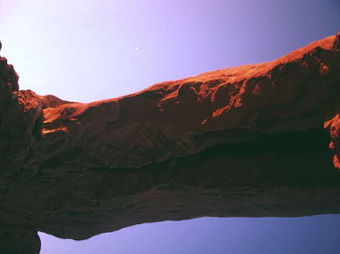Plant and Animal Life in the Desert
A second kind of desert is the stone desert or reg. Regs are vast areas of plain covered rocks and boulders. Nothing can grow there, and the environment is extremely hostile to plant and animal life.
The third desert landscape is of high bare mountains. All soil has been eroded away, leaving just bare rock.
Finally there is the hamada. This type of desert consists of roughly level areas of bare rock. Sand has been swept away by the wind, leaving just the bare rock underneath. Such areas are completely exposed to the sun, making it impossible for anything to grow there.
All of the types of desert landscape are very vulnerable to erosion by the wind. This is because there are very few plants in deserts to bind the soil together. Sand is easily blown by the wind. When the rains do come, the water rushes over rocky areas of desert without soaking in. This adds still further to the process of erosion.
 Outside of the oases, only a few special kinds of plant are able to survive in arid deserts. There are some plants, however, that have adapted to the almost waterless conditions of the desert. These plants are called xerophytes. Xerophytes tend to have small, waxy leaves, which help the plant to retain water. Some, such as cacti, can store water in their trunks. Cacti can be up to 20 metres tall and store more than 5 tonnes of water in their bodies. Many plants have very deep root systems, which can reach up to 15 metres into the soil. Xerophytes also grow very slowly. However, when the rains do come, many desert plants grow new leaves and cacti produce colourful flowers for a few days after the rain.
Outside of the oases, only a few special kinds of plant are able to survive in arid deserts. There are some plants, however, that have adapted to the almost waterless conditions of the desert. These plants are called xerophytes. Xerophytes tend to have small, waxy leaves, which help the plant to retain water. Some, such as cacti, can store water in their trunks. Cacti can be up to 20 metres tall and store more than 5 tonnes of water in their bodies. Many plants have very deep root systems, which can reach up to 15 metres into the soil. Xerophytes also grow very slowly. However, when the rains do come, many desert plants grow new leaves and cacti produce colourful flowers for a few days after the rain.
Rain in the desert also brings to life the ephemeral plants. Their seeds can lie dormant in the soil for up to 20 years. Rainwater causes them to germinate very quickly so that the desert may be carpeted in different varieties of flowers and grasses for between six and eight weeks, after which the flowers die and the desert returns to bare, dry ground until the next rainfall.
Desert dwelling animals also have to be able to cope with extremes of temperature and with chronic water shortage. This has called for a number of adaptations. Birds are active in the cool of the morning and evening and many animals are burrowers, because burrowing allows them to escape from the heat. Other animals come out only at night. Desert animals have had to become very specialized in order to survive. Because of this specialization a desert can appear to be lifeless to the untrained eye.
Read More: Impressive Desert Solar Power